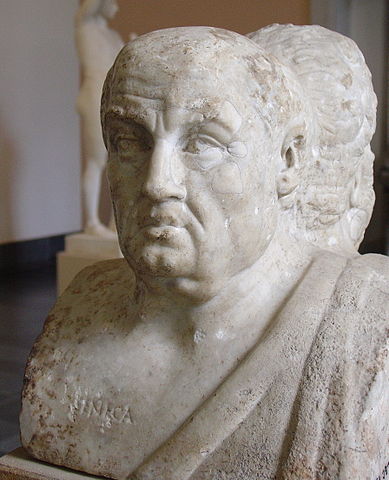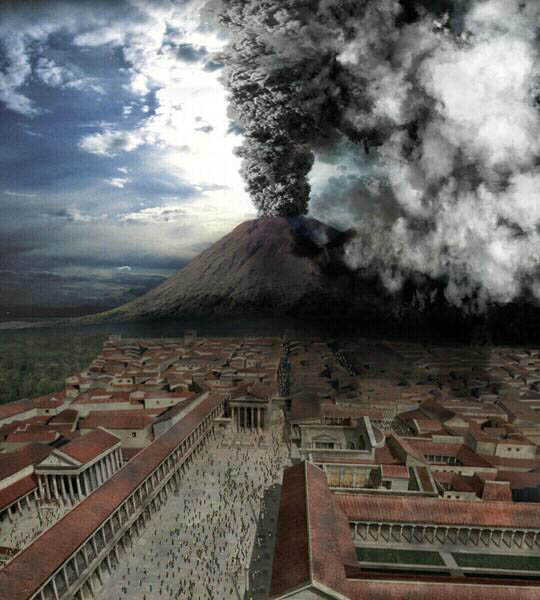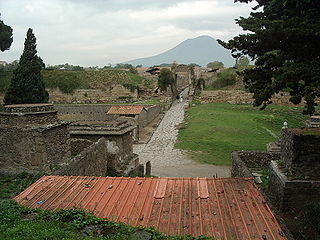An Ancient Earthquake
Today, an ancient earthquake. The Honors College at the University of Houston presents this program about the machines that make our civilization run, and the people whose ingenuity created them.
In 62 AD, a devastating earthquake shook a prosperous town in central Italy. Houses collapsed, massive bronze statues cracked; not even the temples of the gods were spared devastation. Afterwards, people walked about in a helpless daze. It was even reported a flock of hundreds of sheep died mysteriously. What on earth was happening?
We know now that major earthquakes are a product of tectonic activity. Italy is as prone as California to earthquakes; it lies at the subduction zone between the African and Eurasian plates, so there's little one can do about it, except build better buildings. Recent earthquakes north of Bologna have shown how vulnerable Italians still are to sudden death and devastation.
But how did the ancient Romans understand earthquakes? As the wrath of the gods? The philosopher Seneca was certainly keen to understand the calamity, but he wanted only rational explanations. Writing soon after it occurred, he mused at some length about the extraordinary terror earthquakes cause. After all, what can put an end to our fear, when the one thing our universe seems to rest upon proves to be so unstable? What comfort can one find when the very earth offers us no escape? What is more fearsome than an earthquake?

philosopher Seneca
Seneca's answer is that our comfort must lie in knowing the causes of things, and adopting a philosophical resignation that death is always surrounding us. Why fear an earthquake when you can more probably die of a cold? Death is death, regardless. He then launches into a lengthy investigation of all the theories of the time, and lands upon what seems to be the best explanation. Air trapped within the earth is the true cause of earthquakes; as it rushes about through subterranean cavities, it causes vast tremors and at times releases poisonous vapors from deep down below. Such vapors probably killed those sheep. Seneca thus finds his answers.
I doubt the people of this devastated town sought help from philosophers; but rebuild they did, some even ambitiously. One Numerius Popidius laid out the cash to rebuild the fallen temple of Isis, an exotic Egyptian goddess worshipped fairly widely in the town as a savior and bringer of good fortune. Popidius had his motives: he made the repairs to secure his six-year-old son's entrance into the local political assembly. He was clearly thinking of the future. Elsewhere, a new state-of-the-art bath building was being constructed, taking up a whole city block. This was a sure sign that the townsmen had every intention of staying on in their shaky bit of Italy.
Death is everywhere, said Seneca; and he was righter than he knew. Scientists today believe that great earthquake was just a prelude to a far worse catastrophe, though it would take seventeen years for this finally to arrive. You see, this town was called Pompeii, the very one wiped out by the eruption of Vesuvius in 79 AD. So there was something worse to fear than an earthquake after all.

Vesuvius, as it appears from Pompeii.
I'm Richard Armstrong, at the University of Houston, where we're interested in the way inventive minds work.
(Theme music)
Sources:
Seneca, Lucius Annaeus, On Earthquakes (De terrae motu), Natural Questions book 6. Loeb edition, with translation by Thomas Corcoran: Seneca, Naturales Quaestiones II, Harvard UP, 1972.
Williams, Garreth. The Cosmic Viewpoint: A Study of Seneca's Natural Questions. Oxford UP, 2012. See especially chapter 6.
On the 62 AD earthquake, an article detailing the post-event reconstruction done in ancient Pompeii: Martini, Kirk. 'Patterns of Reconstruction at Pompeii.' 1998. http://www2.iath.virginia.edu/struct/pompeii/patterns/
uidoboni, Emanuela. Catalogue of Ancient Earthquakes in the Mediterranean Area up to the 10th Century. Translated by Brian Phillips. Istituto Nazionale di Geofisica, 1994. Pp. 196-210.
Jashemski, W.F. and F. G. Meyer, eds. The Natural History of Pompeii. Cambridge UP, 2002. See especially chapter 3, pp. 33-35 on the earthquake.
On Pompeii generally: Dobbins, John J. and Pedar W. Foss, eds. The World of Pompeii. Routledge, 2007.
On the Isis cult: Witt, R. E. Isis in the Ancient World. Johns Hopkins, 1971.
Images:
- Seneca, part of double-herm in Antikensammlung Berlin. Uploaded to Wikipedia 21 May 2004 by Calidius.
- This is a dramatized scene from Pompeii: The Last Day. It was directed by Peter Nicholson and written by Edward Canfor-Dumas. Vesuvius, as it appears from Pompeii.

photo taken by S'ren Bleikertz
There is significant dramatic license taken in this recreation. In this scene, for example, it appears that Vesuvius is on the outskirts of Pompeii, when in reality it was 10 km (6 miles) away. A true view of Vesuvius from Pompeii can be seen at right.
Also, the depiction of the Temple of Jupiter, facing the forum, and the Temple of Apollo, across the portico to the left, are inaccurate, and the shown state of the porticoes around the forum is also at least questionable. They all appear intact during this recreation of the 79 eruption whereas it is widely known that at least the Temples of Jupiter and Apollo had been destroyed 17 years before, during the 62 earthquake, and that they had not been rebuilt by the time the city was finally destroyed in the 79 eruption. The old forum was destroyed and there was work in progress at 79 for its reconstruction.
This episode was first aired on July 25, 2012